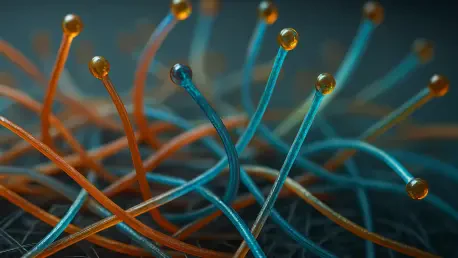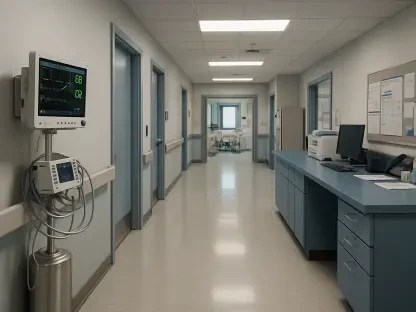Imagine a reality where a simple pencil in your hand tracks muscle strain during writing, a robotic hand senses your heartbeat with a gentle touch, and everyday objects actively contribute to your health and safety. This vision is becoming tangible through the pioneering work of researchers from the University of Cambridge, Hong Kong University of Science and Technology, and Queen Mary University of London. Their development of smart microfibers—ultra-thin conductive threads finer than a human hair—offers a transformative approach to embedding intelligence into common materials like glass, leather, and plastic. By turning mundane items into health monitors and energy devices, this technology hints at a future where the line between passive tools and active systems blurs, enhancing daily life in unexpected ways. The potential to integrate such advanced capabilities without altering an object’s appearance or purpose sparks curiosity about how far this innovation could reach across health care, safety, and technology.
Understanding Smart Microfiber Technology
The Science Behind the Innovation
The foundation of this groundbreaking technology rests on a one-step adaptive fiber deposition process that leverages 3D printing to apply ultra-thin conductive microfibers onto virtually any surface. This method stands out for its precision, allowing the fibers to conform to diverse shapes and textures, whether it’s the curve of a robotic finger or the rough handle of a tool. Unlike traditional manufacturing techniques, this process adapts in real time to the geometry of the object, ensuring seamless integration of smart features. The ability to deposit these fibers on demand means that customization is not only possible but also rapid and cost-effective. Such flexibility positions this technology as a game-changer for industries seeking to embed electronic capabilities into products without extensive redesign or added bulk, paving the way for widespread adoption in various applications.
At the heart of these microfibers is a conductive polymer known as PEDOT:PSS, prized for its transparency and versatility. This material enables the fibers to blend invisibly into host objects while retaining the capacity to perform complex functions like sensing and energy conversion. The adaptability of PEDOT:PSS allows researchers to tailor the fibers for specific tasks, whether it’s detecting vital signs or powering small devices. Beyond functionality, the transparency ensures that the aesthetic and tactile qualities of materials like leather or glass remain unchanged, addressing a key concern in consumer-facing applications. This balance of form and function highlights a thoughtful approach to innovation, where technology enhances without intruding. As a result, the potential to scale this material across diverse sectors—from medical devices to everyday tools—becomes not just feasible but also highly practical for modern needs.
Material Versatility and Design
The versatility of smart microfibers extends beyond their application process to the wide array of materials they can enhance, ranging from rigid glass to flexible leather and even porous graphene aerogels. This broad compatibility stems from the adaptive nature of the 3D printing technique, which adjusts to the unique properties of each surface without compromising structural integrity. Such adaptability ensures that objects retain their original purpose while gaining electronic capabilities, a critical factor in maintaining user familiarity and comfort. For industries, this means that everything from household items to industrial equipment can be upgraded with smart features, opening new avenues for innovation. The ability to work with unconventional materials also suggests a future where technology is no longer confined to specific devices but woven into the fabric of daily life.
Equally compelling is the sustainable design ethos behind these microfibers, as they can be applied and removed without damaging the host object. This non-permanent integration supports a vision of scalability and eco-friendliness, reducing waste associated with disposable electronics. The ease of removal addresses concerns about long-term commitment to embedded technology, allowing users to update or revert objects as needed. Furthermore, the cost-effectiveness of using 3D printing for deployment democratizes access to such advancements, making them viable for both large-scale industrial use and individual customization. This focus on sustainability and accessibility underscores a forward-thinking approach, ensuring that the benefits of smart microfibers are not limited to niche markets but can impact a broader audience across various contexts.
Applications in Health and Safety
Transforming Health Monitoring
One of the most promising applications of smart microfibers lies in their ability to transform everyday objects into real-time health monitoring devices, as demonstrated by remarkable experiments with robotic hands and common tools. In one instance, a robotic hand equipped with 400 PEDOT:PSS microfibers on its fingers successfully detected electrocardiogram (ECG) signals simply by pressing against human skin. Similarly, tools like pencils and pliers, wrapped with hundreds of these fibers, monitored surface electromyography (sEMG) signals during activities such as writing or cutting. These capabilities highlight the potential for non-invasive health tracking embedded into items people already use, eliminating the need for separate wearable devices. The implications for personal health management are profound, as individuals could receive instant feedback on vital signs during routine tasks, fostering a proactive approach to well-being.
The impact of this technology on vulnerable populations, particularly the elderly, and in emergency scenarios cannot be overstated. In home-based care or telemedicine settings, robotic companions with integrated microfibers could periodically assess vital signs like ECG signals, providing critical data to caregivers or medical professionals remotely. This reduces reliance on cumbersome equipment and enhances comfort for those who may struggle with traditional monitoring methods. In emergencies, robotic systems equipped with such sensors could evaluate a person’s cardiac status before first responders arrive, potentially saving lives through faster intervention. By embedding health monitoring into familiar objects and systems, this innovation bridges gaps in access to care, ensuring that critical health insights are available where and when they are needed most, without disrupting daily routines or requiring specialized training.
Enhancing Workplace Safety
In high-risk work environments, smart microfibers offer a lifeline by enabling tools to monitor worker health and prevent injuries through real-time data collection. For workers handling dangerous tasks—such as electrical repairs, chemical processing, or heavy machinery operation—tools embedded with microfibers can track vital signs like heart rate and muscle fatigue via sEMG signals. A plier handle wrapped with 1,000 microfibers, for example, can detect strain during repetitive or forceful tasks, alerting users or supervisors to potential overexertion before it leads to injury. This immediate feedback mechanism serves as an early warning system, allowing for timely breaks or adjustments in workload. The integration of such technology into everyday equipment means safety measures are no longer an afterthought but a built-in feature, fundamentally changing how industries approach employee well-being.
Beyond individual monitoring, smart microfibers also enhance safety in human-robot collaboration by using biopotential data to inform robotic behavior. In collaborative tasks, where humans and robots work side by side, microfibers embedded in tools or robotic components can detect signs of stress or fatigue in the human partner. If elevated stress levels are sensed, the robot can automatically slow down or adjust its actions to reduce strain, creating a safer and more efficient workflow. This responsive interaction is particularly valuable in industries like manufacturing or construction, where precision and timing are critical. By fostering a dynamic partnership between human workers and machines, this technology not only mitigates risks but also boosts productivity, demonstrating a dual benefit that could reshape workplace standards across hazardous sectors.
Future of Human-Machine Interaction
Mimicking Human Touch
Smart microfibers are poised to redefine human-machine interaction by enabling robots and prosthetics to replicate the nuanced sensory capabilities of human touch. By integrating microfiber “skins” onto robotic hands or prosthetic limbs, these systems can detect subtle biopotential signals, such as those from a heartbeat or muscle movement, through direct contact. This capability allows for more natural and intuitive interactions, as machines can respond to human input with a level of sensitivity previously unattainable. For individuals using prosthetics, this means a closer approximation to natural limb function, enhancing both mobility and emotional connection to the device. In robotics, such advancements pave the way for companions or assistants that interact with users in a more empathetic and effective manner, breaking down barriers between human and machine.
The broader implications of mimicking human touch extend to diverse fields, from rehabilitation to personal assistance, where emotional and physical engagement is crucial. In therapeutic settings, robots with microfiber-enabled touch could provide gentle, responsive support to patients recovering from injury or surgery, adapting to their needs in real time. Similarly, in caregiving roles, these systems could offer comfort through lifelike interactions, particularly for the elderly or those with limited mobility. The technology’s unobtrusive nature—thanks to the transparency and thinness of the fibers—ensures that these interactions remain natural, avoiding the cold, mechanical feel often associated with robotics. This shift toward sensory-rich interfaces signals a future where machines are not just tools but partners, capable of understanding and responding to human conditions with unprecedented depth.
A Vision of Intelligence
The integration of smart microfibers into everyday life aligns with a larger trend of embedding intelligence into the world around us, fostering a “Fiber-of-Things” ecosystem that prioritizes both functionality and discretion. Unlike traditional Internet of Things (IoT) devices, which often require dedicated hardware, this technology allows ordinary objects to become smart without altering their form or adding visible bulk. From a chair that monitors posture to a steering wheel that detects driver fatigue, the possibilities are endless for creating environments where technology serves seamlessly in the background. This vision extends the principles of connectivity and data collection to non-wearable items, ensuring that intelligence is ubiquitous yet unobtrusive, enhancing life without demanding attention or adaptation from users.
Sustainability and user-centric design remain central to this vision, as the technology’s adaptability ensures it can meet specific needs across diverse contexts. The ability to customize microfiber applications through 3D printing means solutions can be tailored for individual health concerns, industrial requirements, or personal preferences, all while maintaining affordability. Moreover, the eco-friendly aspect of removable fibers supports a circular approach to tech integration, minimizing waste and encouraging reuse. As industries and individuals look toward smarter, safer, and more connected futures, the emphasis on accessibility ensures that such advancements are not reserved for the few but available to many. This holistic approach hints at a transformative era where the ordinary becomes extraordinary, embedding intelligence into daily interactions with lasting impact.
Reflecting on a Smart Future
Looking back, the journey of smart microfibers marked a pivotal moment when everyday objects transcended their traditional roles to become guardians of health and enablers of connectivity. The seamless fusion of ultra-thin conductive fibers into materials once thought inert reshaped perceptions of technology’s place in daily life. Demonstrations like robotic hands sensing heartbeats and tools detecting muscle strain showcased a remarkable blend of innovation and practicality that touched both personal and industrial spheres. As this technology matured, its adaptability and sustainability stood out as defining traits, ensuring that intelligence could be embedded without sacrifice to form or environment. Moving forward, the focus should shift to scaling these solutions, refining their precision for broader medical and safety applications, and exploring untapped materials for integration. By prioritizing accessibility and collaboration across sectors, the legacy of smart microfibers can evolve into a foundation for a truly connected and responsive world.









